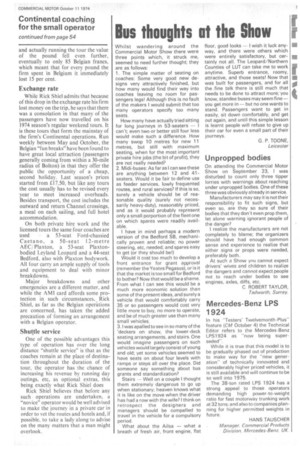Bus thoughts at the Show
Page 61

If you've noticed an error in this article please click here to report it so we can fix it.
Whilst wandering around the Commercial Motor Show there were three points which, it struck me, seemed to need further thought; they are as follows:
1. The simple matter of seating on coaches: Some very good new designs very attractively finished, but how many would find their way into coaches leaving no room for passengers legs! Although this is no fault of the makers I would submit that too Many operators specify too many seats.
How many have actually tried sitting for long journeys in 53-seaters — I can't; even two or better still four less would make such a difference. How many swop 10 metres for new 11 metres, but still with maximum seating, when for the most important private hire jobs (the bit of profit), they are not really needed?
2. Midi-buses: As far as I can see these are anything between 12 and 41seaters. Would it be fair to define use as feeder services, lowly frequented routes, and rural services? If this is so, surely a vehicle should be of reasonable quality (surely not necessarily heavy-duty), reasonably priced, and as it would probably represent only a small porportion of the fleet one on which spares were readily available.
I have in mind perhaps a modern version of the Bedford SB, mechanically proven and reliable; no power steering, etc, needed; and spares easy to get (or they should be!) Would it cost too much to develop a front entrance for grant approval (remember the YeatOS Pegasus), or is it that the market is too small for Bedford to bother? Now that would be a shame. From what I can see this would be a much more economic solution than some of the present ideas, and surely a vehicle that would comfortably carry 35 or so passengers would cost very little more to buy, no more to operate, and be of much greater use than many small vehicles.
3.1 was apal led to see in so many of the 'deckers on show, the lower-deck seating arrangements, and stairs. One would imagine passengers on such vehicles would largely consist of young and old; yet some vehicles seemed to have seats on about four levels with ramps or steps all over the place. Did someone say something about bus grants and standardization?
Stairs -Well on a couple I thought them extremely dangerous to go up when stationary; heaven knows what it is like on the move when the driver has had a row with the wife? I think on retrospect the designers and managers should be compelled to travel in the vehicle for a compulsory period.
What about the Ailsa -what a breath of fresh air, front engine, flat floor, good looks -I wish it luck anyway, and there were others which were entirely satisfactory, but certainly not all. The Leopard/Northern Counties of LUT can take me to work anytime. Superb entrance, roomy, attractive, and those seats! Now that was built for passengers, and for all the fine talk there is still much that needs to be done to attract more; you know, standee buses may seem fine — you get more in -but no one wants to stand. Passengers want to get in easily, sit down comfortably, and get out again, and until this simple lesson is learnt people will refuse to give up their car for even a small part of their journeys.
G. P. TONE, Leicester
Unpropped bodies
On attending the Commercial Motor Show on September 23, I was disturbed to count only three tipper lorries with warnings about reaching under unpropped bodies. One of these three was obviously already in service.
Manufacturers may say it is not their responsibility to fit such signs, but even so, are they so sure of their bodies that they don't even prop them, let alone warning ignorant people of the danger?
I realize the manufacturers are not completely to blame; the organizers should have had enough common sense and experience to realize that either signs or props were needed, preferably both.
At such a Show you cannot expect drivers' wives and children to realize the dangers and cannot expect people not to reach under bodies to see engines, axles, diffs, etc.
C. ROBERT TAYLOR, Tadworth, Surrey.
Mercedes-Benz LPS 1924
In his "Testers' Twelvemonth-Plusfeature (CM October 4) the Technical Editor refers to the Mercedes-Benz LPS1924 as ''now being superseded".
While it is true that this model is to be gradually phased out of production to make way for the "new generation" of technically innovated and considerably higher priced vehicles, it is still available and will continue to be SO well into 1975.
The 38-ton rated LPS 1924 has a strong appeal to those operators demanding high power-to-weight ratio for fast motorway trunking work at 32 tons; and also to companies planning for higher permitted weights in future.
HANS TAUSCHER Manager, Commercial Products Division, Mercedes-Beni, UK.




























































































































































